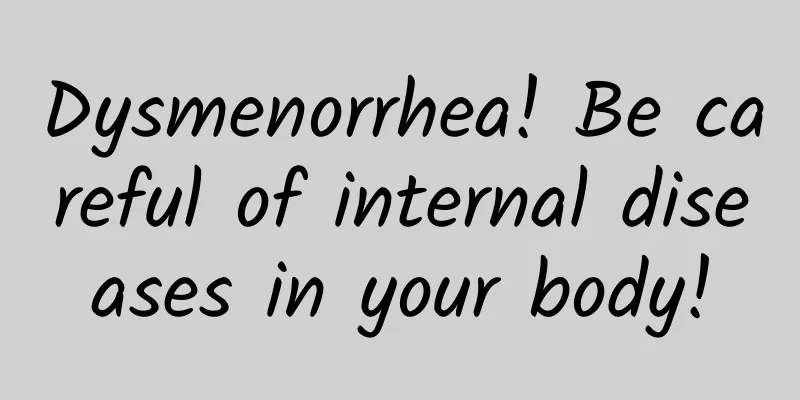Dysmenorrhea! Be careful of internal diseases in your body!

|
Dysmenorrhea is a pain for many women. Once they suffer from dysmenorrhea, they will be in great pain. Understanding the causes of dysmenorrhea is very helpful for the treatment of dysmenorrhea. Especially for middle-aged women, dysmenorrhea is likely to be a reaction to some diseases. Let us introduce the causes of dysmenorrhea. 1. Reproductive tract malformation: This is one of the causes of dysmenorrhea. During embryonic development, the paramesonephric duct on one side can develop well, forming a well-developed unicornuate uterus. However, the paramesonephric duct on the other side develops poorly, forming a rudimentary horn or primordial uterus, which is not connected to the opposite side and does not lead to the body. Primordial uterus generally has no uterine cavity, or has a uterine cavity but lacks endometrium; if the primordial uterus has functional response, manifested as periodic bleeding, dysmenorrhea can be caused by uterine cavity blood accumulation. Most patients are young girls. 2. Uterine fibroids: Dysmenorrhea is not the main symptom of uterine fibroids, but submucosal fibroids can cause spasmodic pain during menstruation due to stimulation of uterine contraction. Patients often have menorrhagia, prolonged menstruation or irregular vaginal bleeding. Pelvic examination can reveal varying degrees of enlargement of the uterus, with a smooth surface or nodular protrusions. 3. Chronic pelvic inflammatory disease: Lower abdominal pain and infertility are the main symptoms of chronic pelvic inflammatory disease. During menstruation, due to pelvic congestion or acute inflammation induced by menstruation, abdominal pain can be aggravated. Most patients have a history of infertility and acute pelvic inflammatory disease. Pelvic examination shows that the uterus is mostly posterior, with poor mobility or even completely fixed. This is also the cause of dysmenorrhea. 4. Intrauterine contraceptive device: Dysmenorrhea can also be seen in women who have an intrauterine contraceptive device placed. This type of dysmenorrhea may be caused by an increase in prostaglandins produced by the endometrium, or it may be that the contraceptive device stimulates the rejection contraction of the uterine muscles, leading to spasmodic pain in the lower abdomen. Patients often have discomfort in the lower abdomen or lumbar region, and their menstrual symptoms are aggravated, manifested as dysmenorrhea. Improper placement of the IUD or excessive size can also easily cause uterine contractions, leading to lower abdominal pain and dysmenorrhea. The above is an explanation of the causes of dysmenorrhea. We hope that it can help you and we feel very honored. The above content is for reference only and cannot be used as a basis for diagnosis and treatment. Because each person has different physical conditions, the degree of disease and symptoms are different, so it is recommended that all diagnosis and treatment should follow the guidance of the doctor. If you have other questions, please consult our online experts for understanding. Dysmenorrheahttp://www..com.cn/fuke/tongjing/ |
<<: Introducing four tips for treating dysmenorrhea
>>: How to deal with dysmenorrhea in daily life
Recommend
Which hospitals in China are the best for treating congenital absence of vagina?
Which hospitals in China are the best for treatin...
Can I take ibuprofen for menstrual cramps?
If the patient is not allergic to ibuprofen, she ...
Causes and treatment of amenorrhea in women
Amenorrhea is a common symptom in women. Girls wi...
Will cervical erosion affect pregnancy? Women with cervical erosion must know these diseases
Many women still worry whether cervical erosion d...
Preventing Sarcopenia for the Elderly - Three Good Ways and One Tip: Eat Healthy, Supplement Calcium and Protein
If the elderly want to live a happy life, they mu...
What Chinese medicine should I take for abnormal leucorrhea
Abnormal leucorrhea can be treated with some Chin...
New Taipei City random inspection: Convenience store rice balls contain excessive E. coli
In May, the New Taipei City Government Health Bur...
Office workers slim belly! Commuter bag to exercise waist curve
A belly that becomes more and more noticeable as ...
How to cure cervical warts
There are many ways to treat cervical warts, main...
Is it easy to treat anemia caused by uterine fibroids?
Anemia caused by uterine fibroids can be improved...
How much does an endometriosis test cost?
The impact of many diseases on patients is not on...
Which hospital is good for treating cervical erosion? Pay attention to these when choosing a hospital for treating cervical erosion
1. Choose a hospital with very good doctors: Afte...
How to perform abortion surgery at three months
If you want to terminate the pregnancy in three m...
What to do if a girl has uterine prolapse
What should girls do if they have uterine prolaps...
Tell about the symptoms of chronic cervicitis
Cervicitis is a common disease in life. There are...









